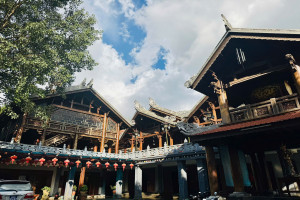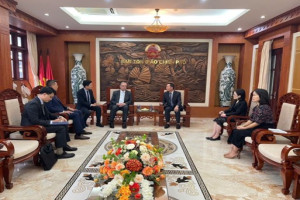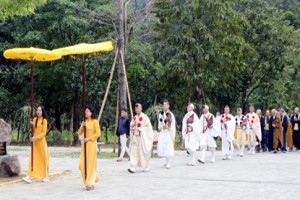
The Dao ethnic minority people observe many ceremonies and festivals each year. Like other Dao branches living in Vietnam’s northern mountain provinces, the Dance Festival of the Dao Tien in Son La province is the biggest community event.

The altar in the house of a head of the clan (photo: VOV)
The Dance Festival is held clan by clan, but it has a common meaning for the whole community. It must be prepared very carefully, including the worship offerings and food to serve the participants.
The Dao Tien in Phien Luong commune, Moc Chau district, hold the Dance Festival at the house of the head of the clan, who is in charge of worshiping the ancestors.
Local resident Lý Trọng Sinh said: “The offering includes fruit, confectionaries, and a pig. The size of the ceremony depends on the size of the community. A clan with few households will organize a small ceremony.”
The Ly clan is preparing red paper for the shamans and senior villagers to decorate the altar. He cuts paper into the shapes of the sun, fish, horses, and dogs and glues them on the altar. Lý Trọng Sinh said they carefully clean the altar before the ceremony.
“We worship Ban Vuong, the progenitor of the Dao, and our clan’s ancestors. The head of the clan is in charge of the clan’s altar. Other families have smaller altars. At the Fire-Jumping Festival we gather at the house of the clan’s head,” said Sinh.

Dancing and singing are part of the Dance Festival of the Dao Tien in Son La province. (photo: VOV)
Before the festival the Dao Tien clean the altar, prepare the offering, and make a tree of fortune. Lý Văn Vinh, Deputy Director of Moc Chau district’s Culture and Communication Center, said: “The tree of fortune represents a bumper harvest. It bears different kinds of fruit, animals such as squirrels and bears, and insects such as bees. We pray for a good crop and good hunting in the forests.”
The Dance ceremony is witnessed by all family members and villagers. It’s a ritual to pray for luck, health, and peace for the family and clan so it must be well organized at the right time and conducted by a shaman.
"The Dance Festival is also called the Crop-praying Festival. We want to preserve our tradition and culture, so we organize it every 3 years,” Lý Trọng Sinh said.
Deputy Director of Moc Chau district’s Culture and Communication Center Lý Văn Vinh said: “The Crop-praying Festival is a sacred event which is held every 2 to 3 years. All family members gather at the house of the clan’s head on the last day of the old year to prepare an offering of chicken, pork, and rice cakes. We celebrate the good year ending and pray for a bumper crop next year.”
During a Dance Festival, ceremony and festive activities interweave. The participants perform rituals, dance, and recite poems. Each person holds a musical instrument such as bells, drums, or gongs, or a worship stick, flag, or sword.
“At first 4 or 6 strong men dance and sing community songs. Then they dance from inside the house to the garden and around the hamlet to chase away evil spirits. Normally the ritual begins at 4 a.m. When they return home it’s already dawn. We perform a ritual to thank our ancestors. Then we dance the Xoe to pray for good fortune and prosperity for our family and the community,” Lý Trọng Sinh said.
Women are not allowed to join the ceremonial dance at the beginning. Only in the Xoe dance do people of all ages and genders dance together.
Lý Văn Vinh said: “On New Year’s Eve we hold a ritual to invite the ancestors and then a ritual to chase away evil spirits. During the day we dance Xoe. The next day they carry swords and flags and repeat the loop until the 2nd day of the New Year.”
The Dance Festival is virtually unknown to the people of other groups, but it is an important community event for the Dao Tien of Phieng Luong district, Son La province.
Source: vovworld.vn/en-US/Giàng Seo Pùa-Vĩnh Phong




